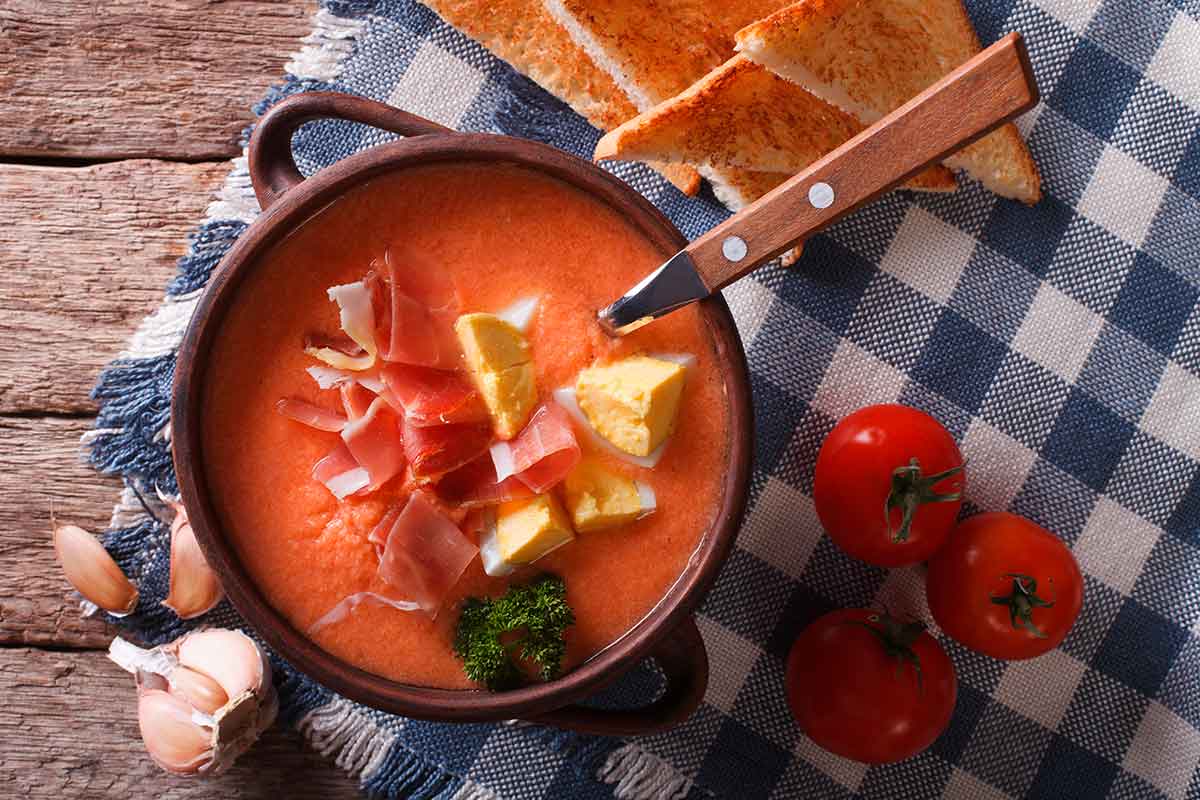
The gastronomy of Andalusia is very diverse. It is the southernmost and hottest region of Spain, which is washed by the Mediterranean Sea and the Atlantic Ocean.
Andalusia consists of 8 provinces: Almeria, Granada, Málaga, Jaén, Córdoba, Huelva, Cadiz, and Seville, whose port was once the first to receive American products such as: potatoes, tomato, peppers, corn, and much more.
Thanks to these new supplies, the cuisine of Andalusia (and indeed the world) has expanded considerably and is now a gastronomic paradise.
Traditional Andalusian food
Each province has its own unique dishes, but they are all made from simple, accessible products that grow on the land.
The proximity to the sea has determined the presence of plenty of fish and seafood in many recipes. However, pork meat is also honored here. So, let's begin our acquaintance with the cuisine of Andalusia with the first dishes - soups.
Gaspacho
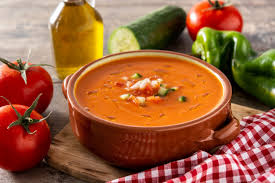
The most famous is gazpacho. The king of all soups - that's what the locals call it.
It is traditionally made of tomatoes, sweet peppers, a piece of bread soaked in water and garlic. Onion and cucumber are added at will.
Everything is mixed in a blender, diluted with water to the desired density and dressed with olive oil and vinegar. A light and refreshing lunch on a sunny summer day.
Salmorejo
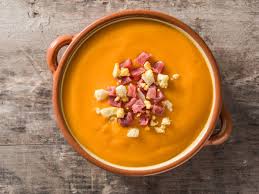
In Cordoba, a similar soup was invented and called salmorejo.
It differs from gazpacho in that salmorejo is made with more bread and is not diluted with water. Thus, this cream soup is more orange and thick. It is served with slices of jamon and boiled eggs.
Ajoblanco
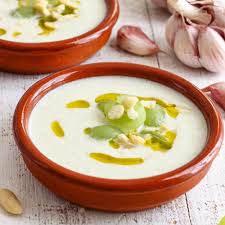
A typical cream - soup for Granada and Málaga is ajoblanco.
It is believed to predate gazpacho and salmorejo because Christopher Columbus had not yet brought tomatoes to Spain.
It used to be a common dish among the poor, who tried to satisfy their hunger by soaking bread in water, rubbing it together and adding some almonds and vinegar.
Nowadays the recipe has not changed much: bread soaked in water is crushed with garlic and raw almonds, adding olive oil and a little vinegar. Garnish with grapes.Hot soups are popular during the cooler seasons.
Gazpachuelo
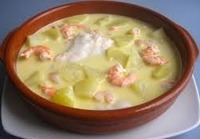
This is a warm soup originating from Málaga. It is a fisherman's dish made of potatoes, seafood (more often fish) and mayonnaise.
Gazpachuelo is one of the most traditional recipes, which pleasantly surprises with its unusual creamy flavor.
Picadillo soup (Sopa de picadillo)
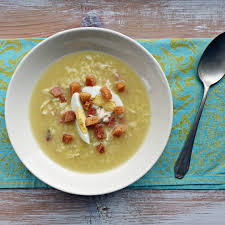
The name of the soup comes from the chopped (picar - to chop, mince) ingredients it contains: usually chicken, egg, meat, vegetables and noodles. Very simple, but no less delicious.
All you need to do is boil chicken and bone broth with a small amount of meat (your choice of pork or beef) and vegetables (usually carrots and leeks). Remove the vegetables and meat, chop, and in the remaining broth boil small noodles.
When ready - pour into deep plates, sprinkle with chopped meat and vegetables, as well as boiled egg, and ready! Very often, when serving, pieces of jamon and herbs are added to the soup.
Andalusian puchero (Puchero andaluz)
It is a thick hot soup of Andalusian cuisine, the main ingredient of which is chickpeas (garbanzo).
Puchero was originally known as the food of the poor people of the region. The broth was drunk and the leftover meat and vegetables were used as ingredients for other dishes. Thus, it could be eaten for several days.
This soup - stew can be found in other places, but the birthplace of the rich puchero is Andalusia. Even now it is always cooked a lot and not eaten immediately. Like the rest, the basis of this recipe is very simple in preparation: boil 2-3 hours of broth from a large amount of meat with chickpeas and vegetables (sometimes chorizo is added to give a special flavor and aroma).
Rice or thin noodles are cooked in the drained broth and served, and the rest is put in a large plate and placed on the table side by side or used in other dishes.
Espeto de sardinas
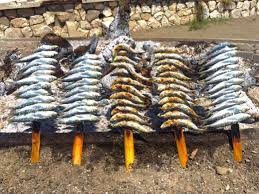
A typical dish of Málaga, Andalusia. It consists of 5 to 6 small sardines threaded on skewers and grilled over charcoal.
Locals say that this dish tastes best from May to August. Although sardines are grilled and served here all year round, it's during these months that they taste the best.
The only way to find out if they are right or wrong is to try them yourself at one of the beach restaurants (chiringuitos).
Fried little fish (Pescaito frito)
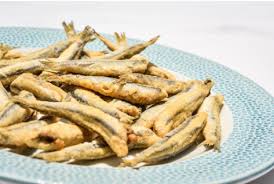
This Mediterranean dish, which originated in Andalusia back in the XIII century, is now popular in almost all restaurants and bars in the south of Spain.
It is a fried small fish in breading in deep fryer. It is impossible to resist crispy outside, but juicy inside seafood.
Although it is a traditional dish of Andalusia, it is also very common in Valencia, Catalonia, the Balearic Islands and the Canary Islands.
Flamenquin
A popular dish from Cordoba in Andalusia. Not for the figure-conscious, though if it's on vacation and just once..
It's a pork tenderloin wrapped around jamon and cheese, rolled in breadcrumbs and deep fried to a crisp in a deep fryer. The side dish is usually French fries. Hearty, simple and very tasty.
Stuffed artichokes (Alcauciles rellenos al estilo andaluz)
A very tasty hot dish. Peeled artichokes are stuffed with minced meat and stewed in a pot.
Pipirrana
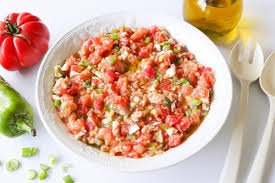
This summer dish comes from Jaen. The salad, which consists of 4 ingredients: peeled tomatoes, green peppers, boiled eggs and tuna, is distinguished from other salads by its dressing. The olive oil, a piece of green pepper, garlic, salt and the yolks of boiled eggs are thoroughly mixed in a mortar.
A very important point, as they say in Jaen, it is necessary to serve bread with this salad, because it is impossible to resist and not drench a piece of it with all the juice formed in the plate. Some regions of Andalusia serve this salad with cucumber or green olives.
Malaga salad (ensalada malagueña)
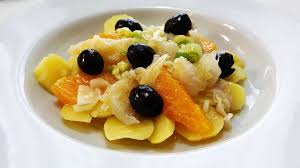
A popular traditional salad in Málaga during the summer. Its main ingredients are: orange, boiled potatoes and salted cod (it is pre-soaked, getting rid of the salt it becomes very tender and tasty).
Cod is sometimes replaced by tuna, but it will be another version of the salad. The remaining ingredients are boiled eggs, olives and onions. They are added for flavor integrity in some regions of Andalusia.
Tapas of Andalusia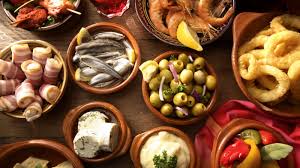
These are small appetizers, according to one version, invented in the XIII century by King Alfonso X of Castile, who, in order to avoid excessive intoxication of his soldiers, ordered innkeepers to serve a small portion of food to the ordered alcohol.
And another version of the origin of tapas is the need to cover the drink with something from flying and inevitably falling insects (in Spanish tapa - cover).
Now this tradition has continued and in some bars in Andalusia tapas such as: a saucer of nuts, chips or olives are served with a soft drink. And others, more solid, can offer the visitor a small plate of fried calamari, shrimp, tortilla, salad, anything. And what exactly will be served is unknown, but it is much more interesting!
Desserts in Andalusia
Sweets in southern Spain bear a resemblance to oriental sweets, often made with honey, anise, almonds and walnuts.
Pestiños
Popular on holidays and beyond, a traditional sweet from the southern cuisine of Spain. These are small pieces of dough fried in olive oil in the shape of a handkerchief. Sesame and anise are often added to the dough. The fried pestiños are sprinkled with sugar or drizzled with honey.
Alfajor
A very popular pastry in Andalusia, alfajor is a sweet mass of almonds, walnuts and honey in a cylindrical shape. Sweet lovers will definitely appreciate it.
Piononos de Santa Fe
Small syrup-soaked biscuit rolls with custard and decorated with caramel crust on top, originating from a small town near Granada - Santa Fe.
Amarguillos
Almond cookie and specialty of the city of Medina Sidonia, part of the province of Cadiz. It is a sweet marzipan with the addition of bitter almonds.
Each city in Andalusia has its own typical dish that you will not regret ordering. Here they know how to feed a hungry tourist!


 English
English  Español
Español  Русский
Русский